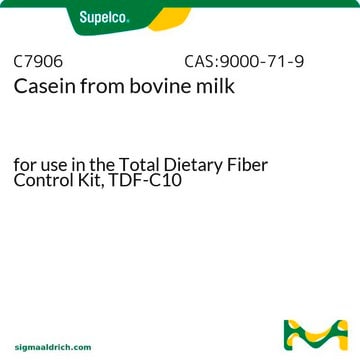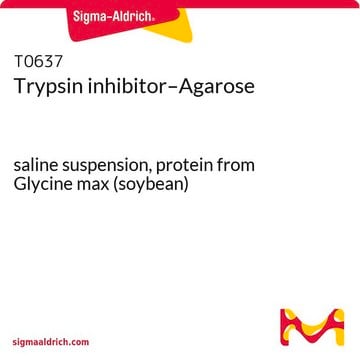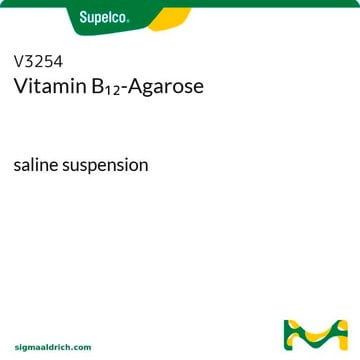Transportation information can be found in Section 14 of the product's (M)SDS.To access the shipping information for this material, use the link on the product detail page for the product.
Wichtige Dokumente
C9210
Cyanogenbromid-aktivierte Agarose
lyophilized powder
Synonym(e):
Agarose, cyclic carbonimidate, CNBr-Activated Agarose
Größe auswählen
Größe auswählen
About This Item
Empfohlene Produkte
Form
lyophilized powder
Methode(n)
affinity chromatography: suitable
Matrix
cross-linked 4% beaded agarose
Aktive Matrixgruppe
cyanate or related structures
Matrix-Spacer
1 atom (when ligands are coupled via isourea derivative or related linkage)
Quellen
1 g swells to 2.5-4.5 mL
Kapazität
≥10 mg/mL binding capacity (BSA)(via amino groups)
Eignung
suitable for chromatography
Lagertemp.
−20°C
Suchen Sie nach ähnlichen Produkten? Aufrufen Leitfaden zum Produktvergleich
Anwendung
Physikalische Form
Lagerklassenschlüssel
11 - Combustible Solids
WGK
WGK 3
Flammpunkt (°F)
Not applicable
Flammpunkt (°C)
Not applicable
Persönliche Schutzausrüstung
Eyeshields, Gloves, type N95 (US)
Hier finden Sie alle aktuellen Versionen:
Analysenzertifikate (COA)
Die passende Version wird nicht angezeigt?
Wenn Sie eine bestimmte Version benötigen, können Sie anhand der Lot- oder Chargennummer nach einem spezifischen Zertifikat suchen.
Besitzen Sie dieses Produkt bereits?
In der Dokumentenbibliothek finden Sie die Dokumentation zu den Produkten, die Sie kürzlich erworben haben.
Kunden haben sich ebenfalls angesehen
-
What is the Department of Transportation shipping information for this product?
1 Antwort-
Hilfreich?
-
-
What do you recommend to use as a negative control for Product C9210, Cyanogen bromide?
1 Antwort-
The control for this product is Product No. CL4B200 (Sepharose CL-4B).
Hilfreich?
-
-
What is the difference between Product C9210, Cyanogen bromide and Product C9142, Cyanogen bromide-activated-Sepharose® 4B?
1 Antwort-
Sigma-Aldrich produces product C9210, while C9142 is produced by GE Healthcare. In addition, C9210 is a cross-linked resin and C9142 is not.
Hilfreich?
-
-
When using Product C9210, Cyanogen bromide, why must amine containing reagents be avoided during coupling?
1 Antwort-
The ligand is attached to the resin via an amine group. If an amine-containing buffer is used during coupling, you will greatly reduce the amount of ligand that can attach.
Hilfreich?
-
Aktive Filter
Unser Team von Wissenschaftlern verfügt über Erfahrung in allen Forschungsbereichen einschließlich Life Science, Materialwissenschaften, chemischer Synthese, Chromatographie, Analytik und vielen mehr..
Setzen Sie sich mit dem technischen Dienst in Verbindung.












